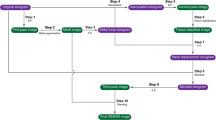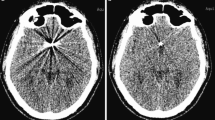Abstract
Purpose
We aimed to assess the impact of metal artifact reduction software (MARs) on image quality of gemstone spectral imaging (GSI) dual-energy (DE) cerebral CT angiography (CTA) after intracranial aneurysm clipping.
Methods
This retrospective study was approved by the institutional review board, which waived patient written consent. From January 2013 to September 2016, single source DE cerebral CTA were performed in 45 patients (mean age: 60 ± 9 years, male 9) after intracranial aneurysm clipping and reconstructed with and without MARs. Signal-to-noise (SNR), contrast-to-noise (CNR), and relative CNR (rCNR) ratios were calculated from attenuation values measured in the internal carotid artery (ICA) and middle cerebral artery (MCA). Volume of clip and artifacts and relative clip blurring reduction (rCBR) ratios were also measured at each energy level with/without MARs. Variables were compared between GSI and GSI-MARs using the paired Wilcoxon signed-rank test.
Results
MARs significantly reduced metal artifacts at all energy levels but 130 and 140 keV, regardless of clips’ location and number. The optimal rCBR was obtained at 110 and 80 keV, respectively, on GSI and GSI-MARs images, with up to 96% rCNR increase on GSI-MARs images. The best compromise between metal artifact reduction and rCNR was obtained at 70–75 and 65–70 keV for GSI and GSI-MARs images, respectively, with up to 15% rCBR and rCNR increase on GSI-MARs images.
Conclusion
MARs significantly reduces metal artifacts on DE cerebral CTA after intracranial aneurysm clipping regardless of clips’ location and number. It may be used to reduce radiation dose while increasing CNR.





Similar content being viewed by others
References
Steiner T, Juvela S, Unterberg A, Jung C, Forsting M, Rinkel G et al (2013) European stroke organization guidelines for the management of intracranial aneurysms and subarachnoid haemorrhage. Cerebrovasc Dis 35(2):93–112. doi:10.1159/000346087
Taha MM, Nakahara I, Higashi T, Iwamuro Y, Iwaasa M, Watanabe Y et al (2006) Endovascular embolization vs surgical clipping in treatment of cerebral aneurysms: morbidity and mortality with short-term outcome. Surg Neurol 66(3):277–284; discussion 84. doi:10.1016/j.surneu.2005.12.031
Zhao B, Tan X, Yang H, Li Z, Zheng K, Xiong Y et al (2016) Endovascular coiling versus surgical clipping for poor-grade ruptured intracranial aneurysms: postoperative complications and clinical outcome in a multicenter poor-grade aneurysm study. AJNR Am J Neuroradiol 37(5):873–878. doi:10.3174/ajnr.A4649
Wallace RC, Karis JP, Partovi S, Fiorella D (2007) Noninvasive imaging of treated cerebral aneurysms, part II: CT angiographic follow-up of surgically clipped aneurysms. AJNR Am J Neuroradiol 28(7):1207–1212. doi:10.3174/ajnr.A0664
van der Schaaf I, van Leeuwen M, Vlassenbroek A, Velthuis B (2006) Minimizing clip artifacts in multi CT angiography of clipped patients. AJNR Am J Neuroradiol 27(1):60–66
Mamourian AC, Pluta DJ, Eskey CJ, Merlis AL (2007) Optimizing computed tomography to reduce artifacts from titanium aneurysm clips: an in vitro study. Technical note. J Neurosurg 107(6):1238–1243. doi:10.3171/JNS-07/12/1238
Tomandl BF, Kostner NC, Schempershofe M, Huk WJ, Strauss C, Anker L et al (2004) CT angiography of intracranial aneurysms: a focus on postprocessing. Radiographics 24(3):637–655. doi:10.1148/rg.243035126
Brook OR, Gourtsoyianni S, Brook A, Mahadevan A, Wilcox C, Raptopoulos V (2012) Spectral CT with metal artifacts reduction software for improvement of tumor visibility in the vicinity of gold fiducial markers. Radiology 263(3):696–705. doi:10.1148/radiol.12111170
Luo S, Zhang LJ, Meinel FG, Zhou CS, Qi L, McQuiston AD et al (2014) Low tube voltage and low contrast material volume cerebral CT angiography. Eur Radiol 24(7):1677–1685. doi:10.1007/s00330-014-3184-z
Shinohara Y, Sakamoto M, Iwata N, Kishimoto J, Kuya K, Fujii S et al (2014) Usefulness of monochromatic imaging with metal artifact reduction software for computed tomography angiography after intracranial aneurysm coil embolization. Acta Radiol 55(8):1015–1023. doi:10.1177/0284185113510492
Morgan CJ, Aban I (2016) Methods for evaluating the agreement between diagnostic tests. J Nucl Cardiol 23(3):511–513. doi:10.1007/s12350-015-0175-7
Zhang D, Li X, Liu B (2011) Objective characterization of GE discovery CT750 HD scanner: gemstone spectral imaging mode. Med Phys 38(3):1178–1188. doi:10.1118/1.3551999
Matsumoto K, Jinzaki M, Tanami Y, Ueno A, Yamada M, Kuribayashi S (2011) Virtual monochromatic spectral imaging with fast kilovoltage switching: improved image quality as compared with that obtained with conventional 120-kVp CT. Radiology 259(1):257–262. doi:10.1148/radiol.11100978
Lin XZ, Miao F, Li JY, Dong HP, Shen Y, Chen KM (2011) High-definition CT gemstone spectral imaging of the brain: initial results of selecting optimal monochromatic image for beam-hardening artifacts and image noise reduction. J Comput Assist Tomogr 35(2):294–297. doi:10.1097/RCT.0b013e3182058d5c
Kuchenbecker S, Faby S, Sawall S, Lell M, Kachelriess M (2015) Dual energy CT: how well can pseudo-monochromatic imaging reduce metal artifacts? Med Phys 42(2):1023–1036. doi:10.1118/1.4905106
Lee YH, Park KK, Song HT, Kim S, Suh JS (2012) Metal artefact reduction in gemstone spectral imaging dual-energy CT with and without metal artefact reduction software. Eur Radiol 22(6):1331–1340. doi:10.1007/s00330-011-2370-5
Jia Y, Zhang J, Fan J, Li C, Sun Y, Li D et al (2015) Gemstone spectral imaging reduced artefacts from metal coils or clips after treatment of cerebral aneurysms: a retrospective study of 35 patients. Br J Radiol 88(1055):20150222. doi:10.1259/bjr.20150222
Bahner ML, Bengel A, Brix G, Zuna I, Kauczor HU, Delorme S (2005) Improved vascular opacification in cerebral computed tomography angiography with 80 kVp. Investig Radiol 40(4):229–234. doi:10.1097/01.rli.0000155281.32319.52
Dolati P, Eichberg D, Wong JH, Goyal M (2015) The utility of dual-energy computed tomographic angiography for the evaluation of brain aneurysms after surgical clipping: a prospective study. World Neurosurg 84(5):1362–1371. doi:10.1016/j.wneu.2015.06.027
Author information
Authors and Affiliations
Corresponding author
Ethics declarations
Funding
No funding was received for this study.
Conflict of interest
The authors declare that they have no conflict of interest.
Ethical approval
All procedures performed in this study were in accordance with the ethical standards of the institutional review board and the ethics committee of the State of Vaud and with the 1964 Helsinki declaration and its later amendments or comparable ethical standards. For this type of study formal consent is not required.
Informed consent
For this type of retrospective study, formal consent is not required.
Rights and permissions
About this article
Cite this article
Dunet, V., Bernasconi, M., Hajdu, S.D. et al. Impact of metal artifact reduction software on image quality of gemstone spectral imaging dual-energy cerebral CT angiography after intracranial aneurysm clipping. Neuroradiology 59, 845–852 (2017). https://doi.org/10.1007/s00234-017-1871-6
Received:
Accepted:
Published:
Issue Date:
DOI: https://doi.org/10.1007/s00234-017-1871-6




